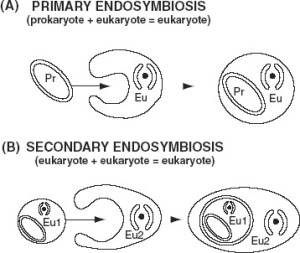What is the difference between primary and secondary endosymbiosis?
1 Answer
1) The sequencing of the engulfing and absorbing of genetic material
2) Whether prokaryotic or eukaryotic cells are absorbed by a eukaryotic cell
Explanation:
Primary endosymbiosis occurs when a eukaryotic cell engulfs and absorbs a prokaryotic cell, such as a smaller cell that undergoes photosynthesis (eg. cyanobacteria).
Secondary endosymbiosis occurs when a eukaryotic cell engulfs and absorbs another eukaryotic cell.
The endosymbiotic theory is how scientists think mitochondria and chloroplasts evolved in eukaryotic organisms. Before mitochondria and chloroplasts were organelles in a cell, they were prokaryotes that were absorbed by eukaryotic cells.
Another difference in the theories is the sequencing. Primary endosymbiosis is thought to have occurred first. Secondary endosymbiosis occurred second. Both involve the theoretical process of one cell absorbing genetic material from a smaller preexisting organism to increase the complexity of the resulting symbiotic union.


